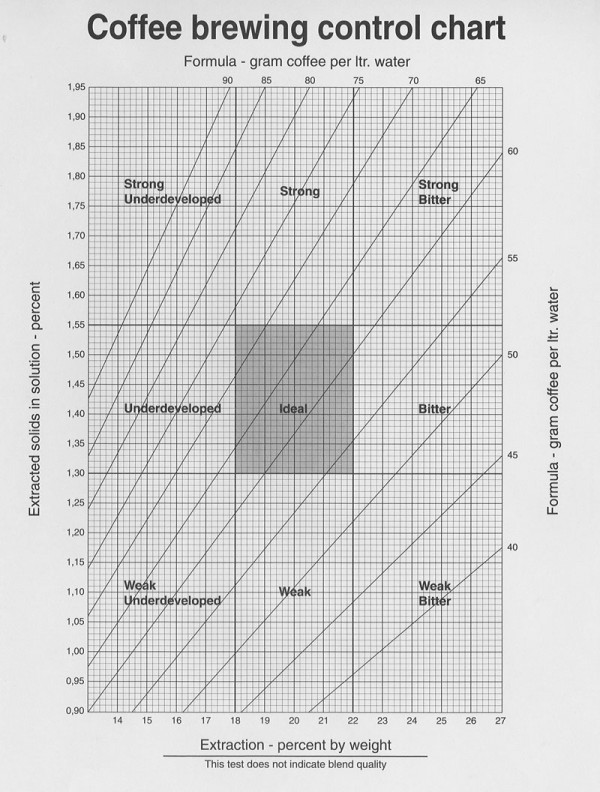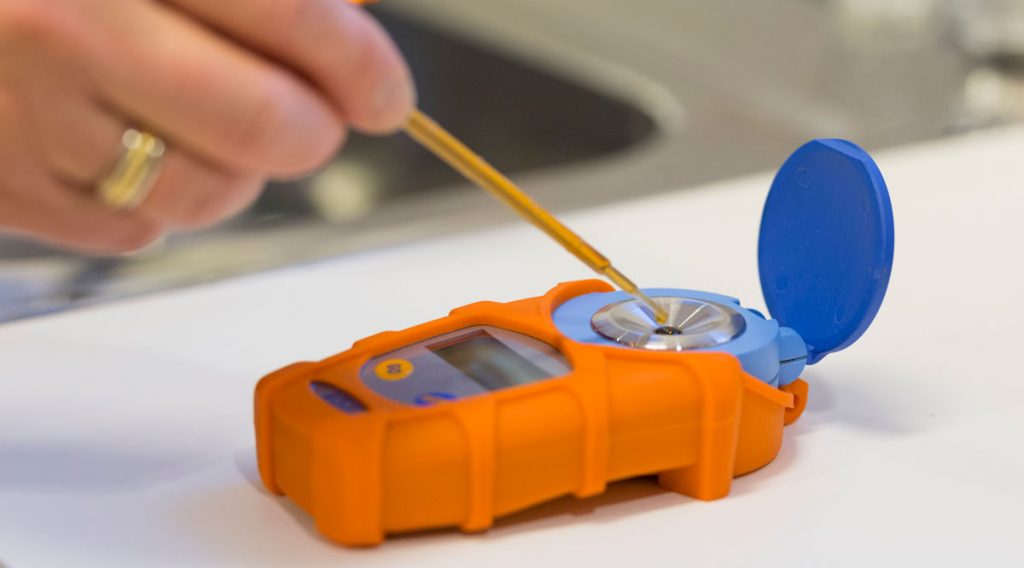All coffee brewers will be sent to ECBC’s office in Oslo to begin the evaluation process. ECBC will return all brewers at the completion of the tests. All test results will remain confidential unless instructed otherwise by the manufacturer or until such time as the manufacturer signs the Licensing Agreement.
The standard covers the specifications and test methods for filter coffee brewers and fresh brew/vending coffee machines. Manual brewing devices (i.e., pour over devices), non-filter brewing devices (i.e., French press style), home espresso machines, pressurized brewing devices, and pod/capsule brewers are not included in this standard.
All tests will follow a standard format that conforms to the good brewing practices outlined in this manual. In summary, ECBC will ensure all tests use:
- Fresh, cold water with a temperature of 15ºC – 20º C .
- The proper grind for the required brewing time of the coffee-brewing device.
- A ratio equivalent to at least 60 grams of coffee pr litre of water.
- The water contact temperature is measured in the centre of the filter unit on the surface of the coffee.
- The voltage used during the test will be adjusted to obtain the given wattage of the coffee maker.
- All equipment is tested at full capacity, and one (1) litre.
If a brewing device is designed to operate at varying capacities and has passed the full-capacity performance test, it will then be tested for the other rated capacities. It must achieve the same performance rating at this level as at full capacity. No unit will be tested at less than two-thirds capacity, unless it has been specifically designed for this operation.
To qualify for the ECBC Seal of Approval, a brewer must meet the following standards in seven areas:
1. Brewing Time and coffee grind
Repeated studies have shown that prolonged brewing time adversely affects cup flavour. Because brewing time relates directly to coffee grind, or particle size, equipment designs may be modified to give shorter – or, in some cases, longer – water contact times.
In testing coffee brewers, ECBC will use the grind for brewing times of 4 to 6 minutes (ECBC standard filter grind). A fresh brew/ vending coffee machine will typically have an extraction time of 25- 45 seconds. We will use a coffee grind that matches the extraction time . When the fresh brew/vending coffee machine has a built in grinder it will be adjusted accordingly.
Grind classification will be determined using the air sieve measure method. Either the method of heating or delivering the water usually determines the brewing time. In some equipment designs, both of these factors control time. In brewing devices that provide for preparing varying quantities, the time for brewing either the minimum or maximum quantity should remain with in the range of the designated grind; the consumer shouldn’t need to buy a variety of grinds in order to prepare different quantities of brew. In this situation, the test will evaluate brewing times at full capacity and at two-thirds capacity. Whenever possible, the actual brewing times will be determined from time-temperature recorder charts.
2. Brewing Temperature
A coffee brewer will meet the temperature requirements if, during normal operation, the temperature in the brew basket reaches 92ºC within the first minute of the brew, and stays between 92- 96ºC throughout the brew cycle. The temperature should never exceed 96ºC.
A fresh brew vending machine will meet the temperature requirements if, during normal operations, the temperature in the brew chamber reaches 92C within a few seconds and stays between 92- 96C throughout the brew cycle. The temperature should never exceed 96C.
Measurement of brewing temperatures will be made by using an RTD (Resistive Temperature Device). The sensors will be placed in the brewers to produce a correct and useful picture of the temperature and the changes in the temperature throughout the brewing process. The water contact temperature is measured in the centre of the filter unit on the surface of the coffee. This condition applies to brewers used both at partial and at full capacity.
3. Solubles Concentration Measurement
Under the conditions set up for ECBC’s equipment evaluation, the solubles concentration (strength) of the beverage may range from 1.30% to 1.55%. Any value greater or less than these indicates that the equipment isn’t performing satisfactorily or that the brewing technique isn’t acceptable.
4. Solubles Yield
The value for the solubles concentration will be plotted on the Coffee Brewing Control Chart and extended to the diagonal line that represents the coffee-to-water ratio of 60 grams per litre.
The solubles yield (extraction) – how much coffee flavouring material has been removed from the bed of coffee grounds – can then be ascertained. The solubles yield may range between 18.0% to 22.0%. Any value lower or higher than these indicates that the equipment isn’t performing satisfactorily and isn’t acceptable.

5. Uniformity of Performance
To determine how uniformly the coffee beverage can be prepared in the equipment, the evaluator will prepare 10 separate batches of the beverage. Samples of each batch will be analysed for solubles concentration using the coffee refractometer and extraction calculated using the Coffee Brewing Control Chart.
The requirements for a beverage strength (solubles concentration) is between 1.30% to 1.55%, resulting from an extraction (solubles yield) of between 18,0% to 22,0%. This being determined by a coffee refractometer and the Coffee Brewing Control Chart.

6. Uniformity of Extraction
The requirement is that an even and homogeneous extraction be achieved from the entire bed of coffee.
For coffee brewers all of the coffee in the brew basket must be moistened during the first minute of the contact time.
For fresh brew vending machines all the coffee should be moistened within the first seconds.
In some brewing devices, water may not be applied uniformly to the grounds or the coffee and water may not mix completely. Non-uniformity of extraction points to design or functional defects in a brewer. It clearly indicates that the distinct phases of wetting and extraction aren’t proceeding in a uniform manner. Non-uniformity of extraction results in mixing grassy under-developed tastes with astringent and bitter over-extracted tastes, resulting in a less flavourful coffee beverage.
Aside from visual observation, the only way of assessing uniformity of grounds extraction is to sample the bed of grounds after the brewing cycle has concluded and to measure the residual soluble material.
Brewers will receive a quality performance index rating based on the average uniformity of extraction factor as determined by Agtron/ SCAA Uniformity of extraction prosedures.
The rating number is calculated by comparing residual soluble solids in the outside, middle, and inside areas of the wet coffee grounds in the brew basket. The result is multiplied by 100 to convert the percentage to a whole number.
The Index Rating is 0 – 100, with 100 indicating perfect uniformity of extraction. An average uniformity rating number of 60 would be considered “good,” a rating number above 75 would be considered “excellent,” and a rating number above 90 would be “outstanding.” All ratings below 60 would be listed as “needs improvement” and could result in the brewer not being approved.
Download Uniformity of Extraction Evaluation Procedure
7. Physical Measurements
Good coffee beverages require careful measurement of both coffee grounds and water. The brew basket and beverage receiver must be large enough to accommodate the desired coffee-to-water ratio. In evaluating this aspect of equipment design, ECBC applies the following rules:
- One gram of ground coffee absorbs two 2 millilitres of water.
- The “standard” ratio of coffee to water for comparative purposes is 50-60 grams per litre.
- Water capacities or beverage yields may not differ from those measured or incrementally marked on the equipment by more than 5%.
(Water volumes are measured at room temperature 25ºC. The difference between liquid volumes at 100ºC and 25ºC is 3%. In other words, volumes measured at about 100ºC contain 3% less water, or coffee beverage, than when these same fluids have cooled to 25ºC.) - For home-brewers ECBC recommend that fluid-level markings show standards units of 250 millilitres.
- The beverage receiver and the brew basket should have a proportional relationship.
If, for example, the beverage receiver can hold 1,5 litre, then the brew basket should accommodate 90 grams of roast-and-ground coffee. - Because coffee grounds increase in volume during the water contact period, the total depth of the basket must allow for swelling. This allowance should be about 50% of the bed depth of the coffee.
- Catering-brewers usually have filter baskets cylindrical in shape. For best results, the cylinder should provide bed depths between 2.5 cm and 5.
